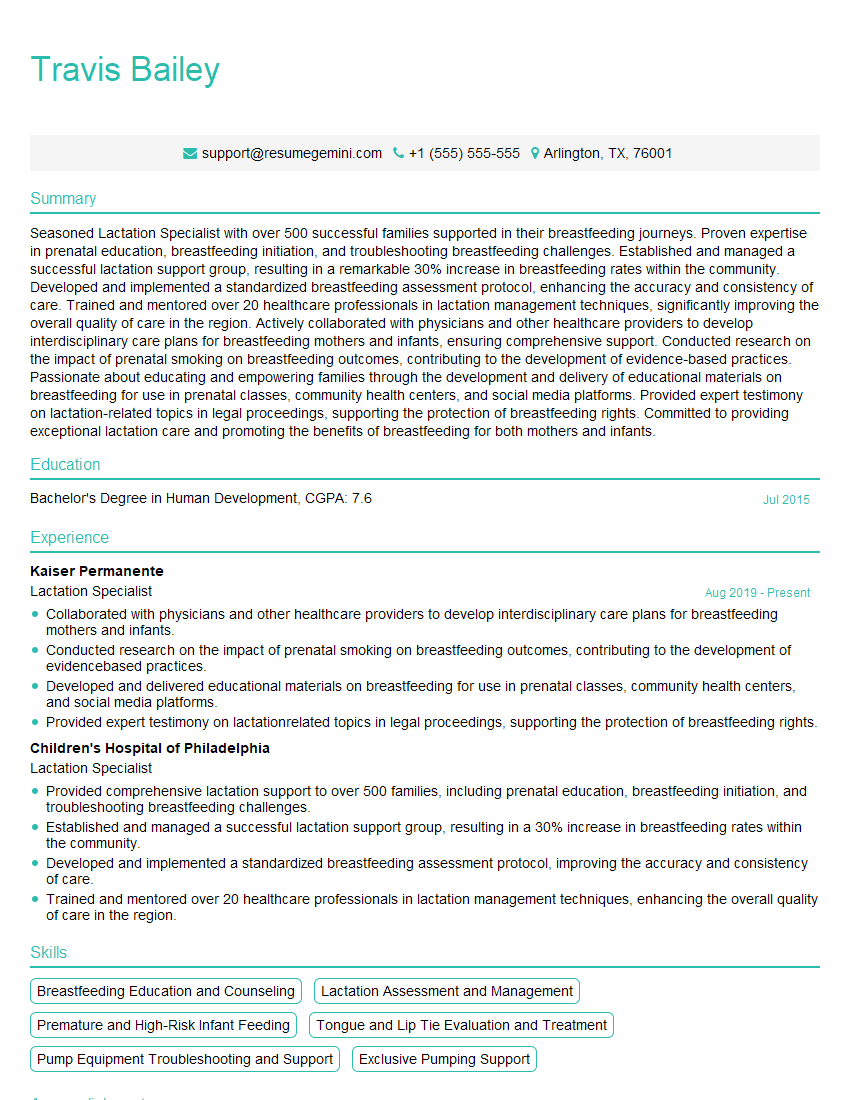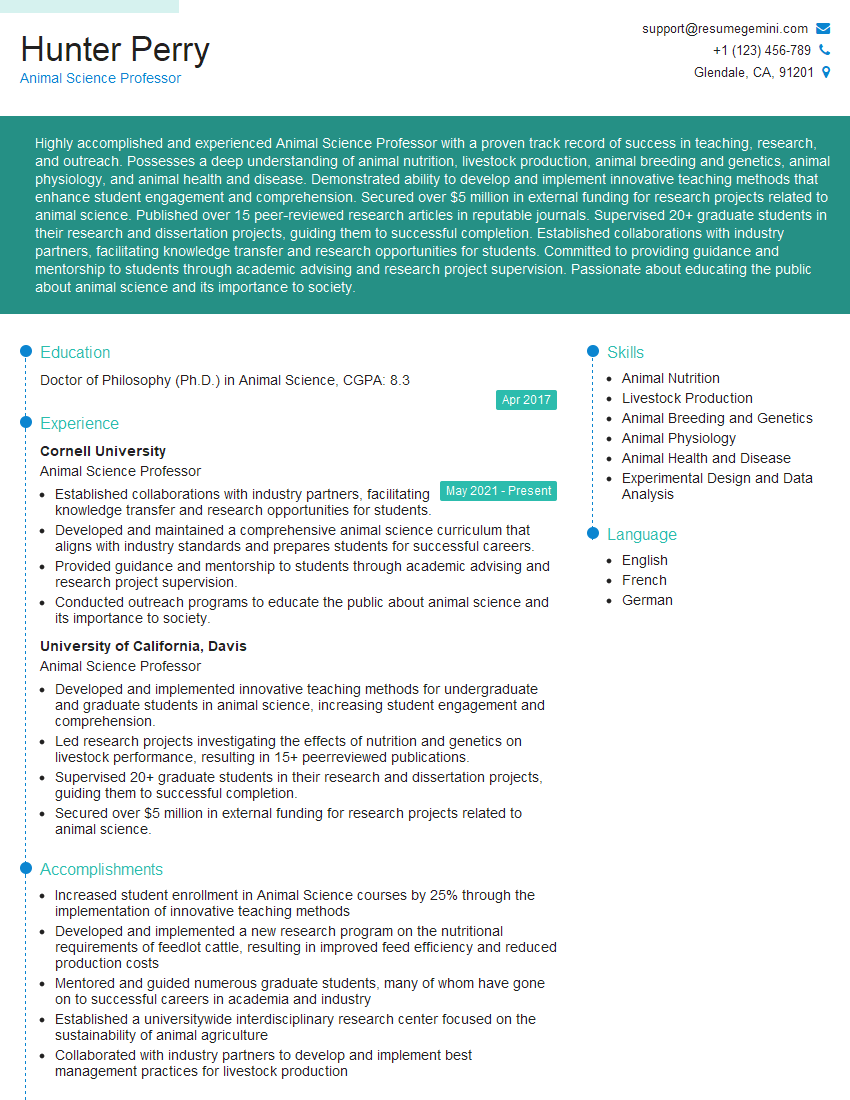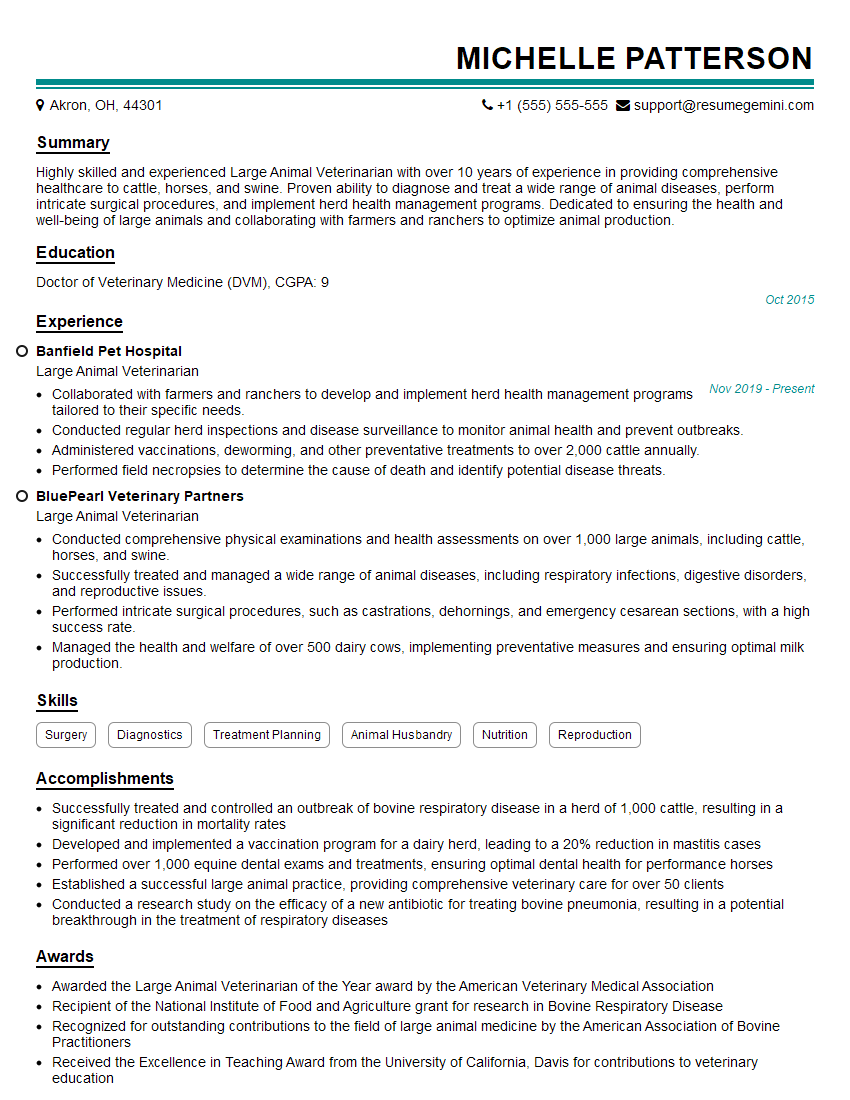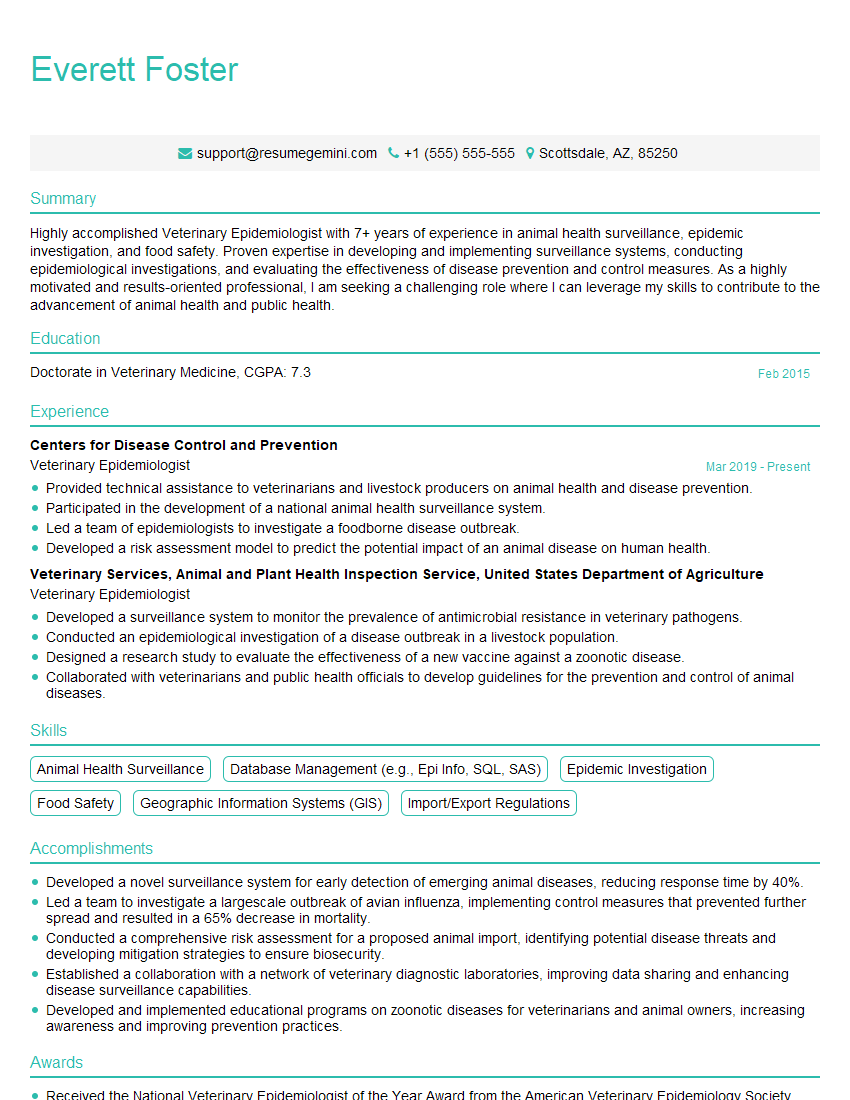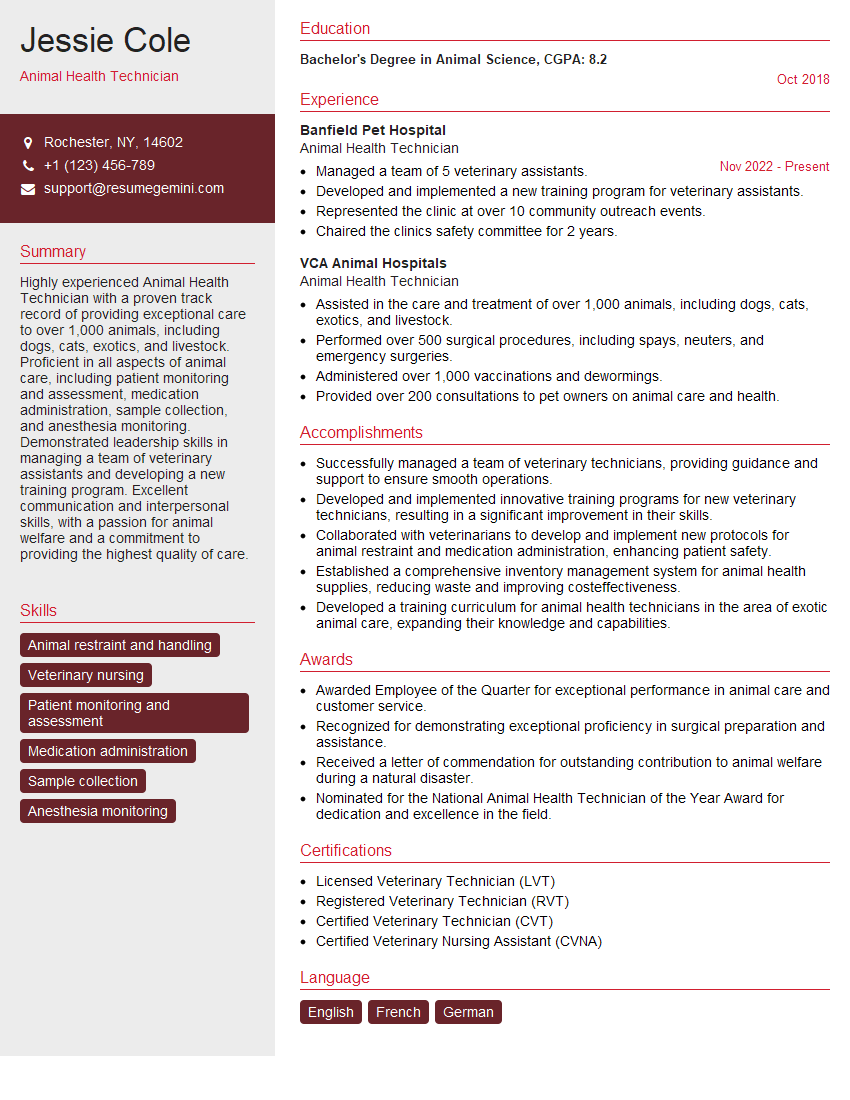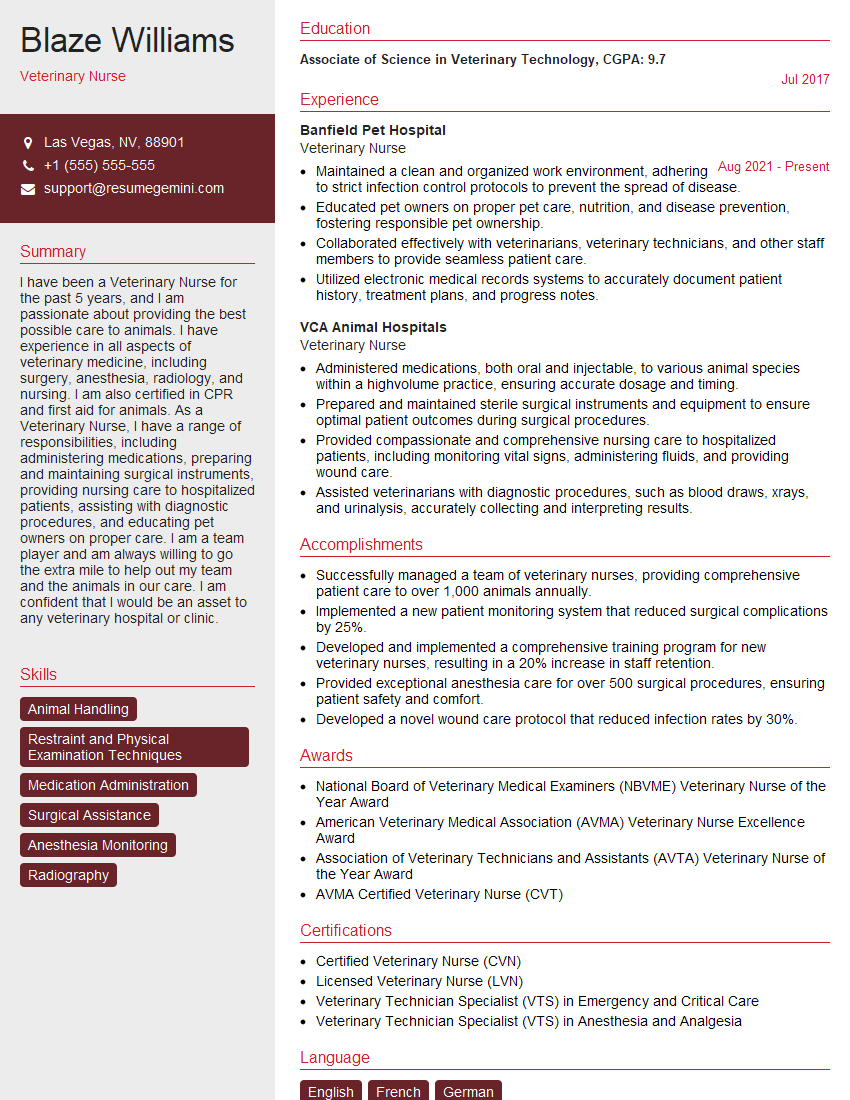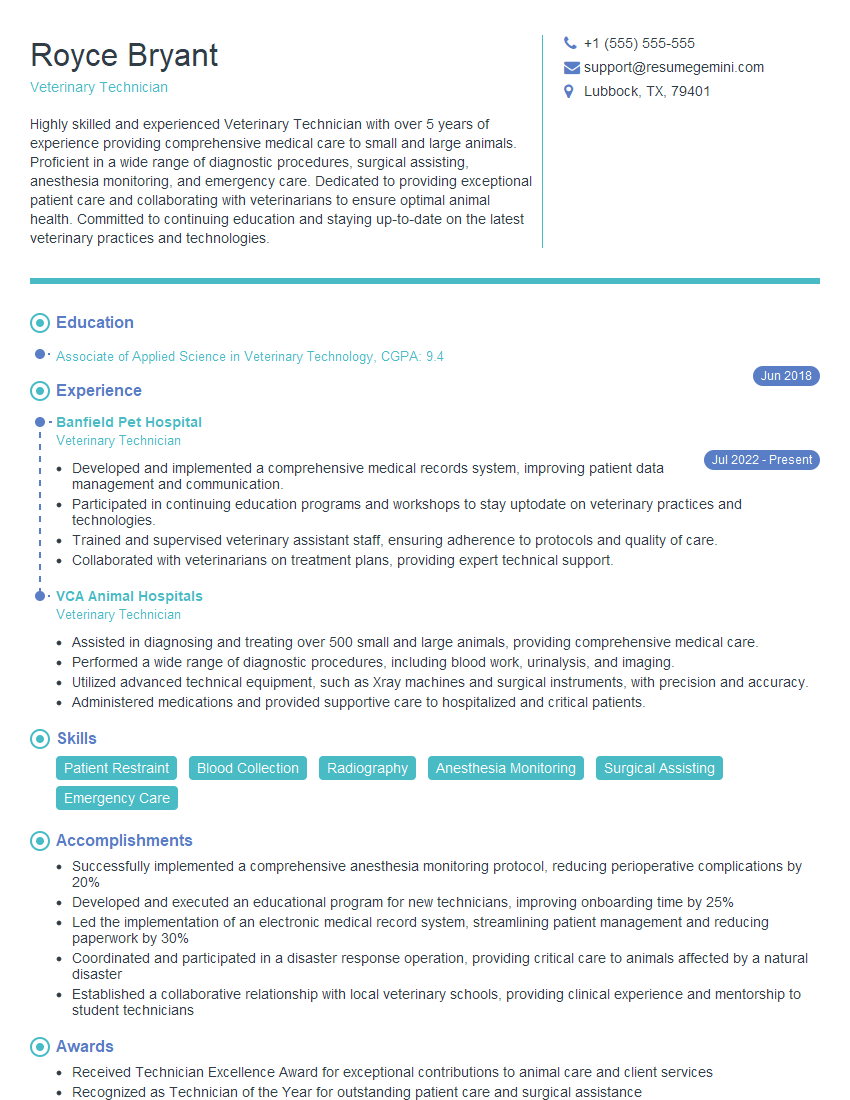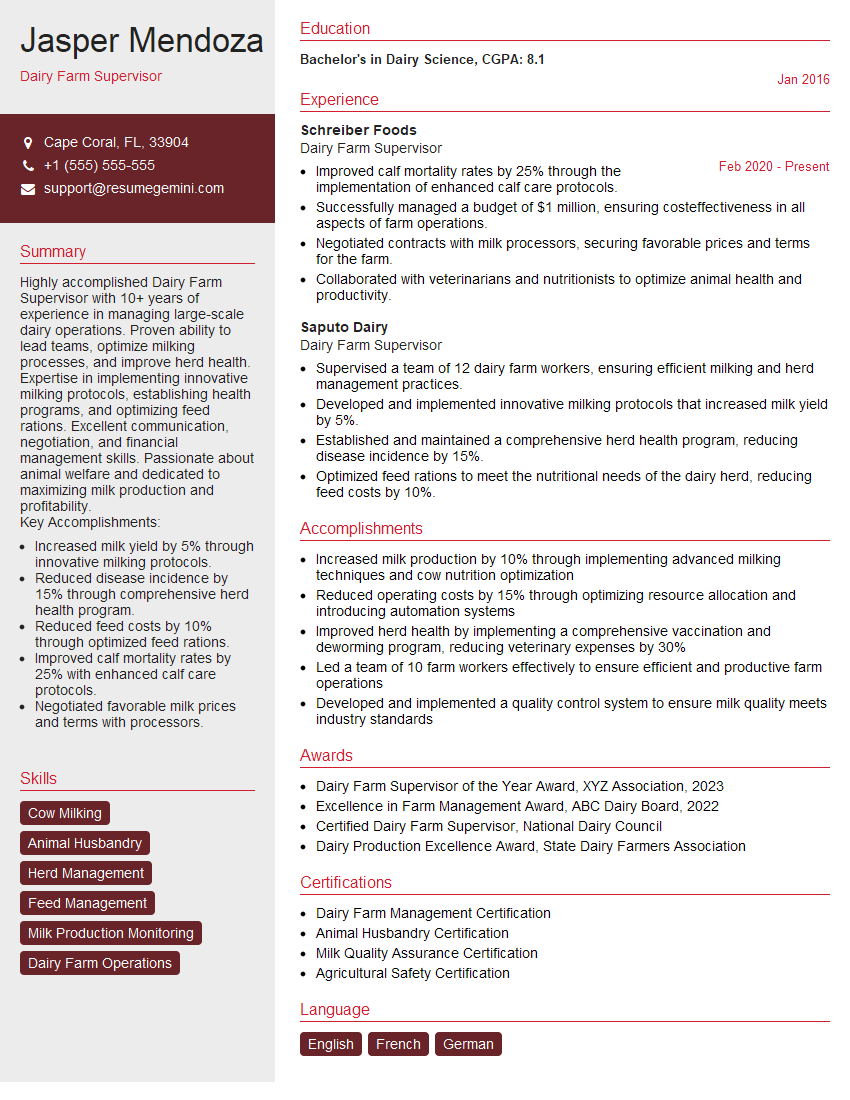Feeling uncertain about what to expect in your upcoming interview? We’ve got you covered! This blog highlights the most important Mastitis detection and treatment interview questions and provides actionable advice to help you stand out as the ideal candidate. Let’s pave the way for your success.
Questions Asked in Mastitis detection and treatment Interview
Q 1. Describe the different stages of mastitis.
Mastitis, an inflammation of the mammary gland, typically progresses through several stages. It’s crucial to understand these stages for effective management.
- Stage 1: Subclinical Mastitis: This is the most insidious stage. The cow shows no outward signs of illness, but the milk contains elevated somatic cell counts (SCC), indicating an infection. Think of it like a silent infection, brewing beneath the surface. Early detection is key here.
- Stage 2: Mild Clinical Mastitis: In this stage, subtle changes become apparent. The cow might exhibit slight changes in milk (e.g., flakes, clots, slightly altered color or consistency). She might also display mild discomfort during milking, but her overall demeanor remains relatively normal. Imagine a mild cold—you feel a little off, but can still function.
- Stage 3: Moderate to Severe Clinical Mastitis: Here, the signs are much more pronounced. The udder is visibly inflamed, often hot, swollen, and painful to the touch. The milk might be watery, bloody, or contain thick clots. The cow shows systemic symptoms like fever, depression, and reduced milk yield. This is comparable to a severe flu, impacting the cow’s general health.
- Stage 4: Chronic Mastitis: This is a persistent or recurring infection. The udder may become permanently damaged, leading to reduced milk production, fibrosis (scarring), and potential loss of the affected quarter. This stage represents a long-term impact, much like the lasting effects of some chronic illnesses.
Q 2. Explain the various methods for detecting subclinical mastitis.
Detecting subclinical mastitis, which shows no visible symptoms, relies on indirect methods. These primarily focus on analyzing the milk:
- California Mastitis Test (CMT): A rapid, on-farm test that measures the viscosity of milk after reacting with a reagent. A positive result indicates an elevated SCC, suggestive of infection. It’s simple and inexpensive, making it widely used.
- Somatic Cell Count (SCC) analysis: This precise laboratory test counts the white blood cells (somatic cells) in the milk. High SCC indicates inflammation and infection. A regular SCC monitoring program allows for early detection and proactive intervention.
- Electrical Conductivity Measurement: This method assesses the electrical conductivity of milk, which increases with infection due to altered ion concentrations. It’s another quick screening method.
- Milk Culture: This test identifies the specific bacteria causing mastitis. While not a screening test, it’s crucial for guiding targeted antibiotic treatment.
Imagine SCC analysis as a blood test for a human: It doesn’t show the symptoms of a disease, but reveals underlying inflammatory processes.
Q 3. What are the common clinical signs of mastitis?
Clinical mastitis presents with noticeable symptoms, varying in severity:
- Changes in milk: Watery, clotty, bloody, or discolored milk.
- Udder changes: Swelling, heat, redness, and pain in the affected quarter(s).
- Systemic signs: Fever, depression, reduced appetite, lameness, and reduced milk production.
- Hard or lumpy areas in the udder: Indicative of fibrosis or abscess formation.
For instance, imagine a farmer noticing a quarter of the udder is visibly swollen and red. This, accompanied by fever and reduced milk yield, clearly points towards a clinical case of mastitis.
Q 4. Discuss the different types of mastitis (e.g., contagious, environmental).
Mastitis is broadly classified into two major types:
- Contagious Mastitis: This type is primarily caused by bacteria that are easily transmitted from cow to cow, most notably Staphylococcus aureus. These bacteria typically colonize the udder and persist even in subclinical cases. Contagious mastitis often leads to persistent infections and chronic problems. Think of it as an infection that spreads easily within a herd.
- Environmental Mastitis: This type is caused by bacteria from the cow’s environment, such as Escherichia coli and various environmental streptococci. These bacteria typically enter the udder through the teat canal, often during milking. Environmental mastitis is often associated with poor hygiene practices.
The distinction between the two is crucial for determining appropriate control strategies. Contagious mastitis requires focused efforts on culling infected cows and strict hygiene protocols, while environmental mastitis calls for improvements in sanitation and milking practices.
Q 5. What are the risk factors associated with mastitis?
Several factors increase the risk of mastitis:
- Poor milking hygiene: Inadequate cleaning and sanitization of teats and equipment.
- Teat injury: Injuries to the teats create entry points for bacteria.
- High somatic cell counts: Indicates ongoing inflammation, making the udder more susceptible to infection.
- Stress: Heat stress, transportation stress, and other stressors weaken the cow’s immune system.
- Poor udder conformation: Udder structure that makes it more difficult to clean and milk thoroughly.
- Age: Older cows tend to be more susceptible.
- Mastitis history: Cows with a previous history of mastitis are at higher risk of recurrence.
- Poor nutrition: Inadequate nutrition weakens the cow’s immune system.
Think of these risk factors as building blocks: The more risk factors present, the higher the likelihood of a cow developing mastitis. A farmer must address these systematically to create a healthier herd.
Q 6. Explain the importance of proper milking hygiene in mastitis prevention.
Proper milking hygiene is paramount in preventing mastitis. It involves a multi-step process:
- Pre-milking teat preparation: Thoroughly cleaning the teats with an appropriate disinfectant to remove dirt and bacteria. This is like washing your hands before surgery—crucial for preventing infection.
- Post-milking teat disinfection: Applying a teat dip to the teats after milking to prevent bacterial entry. This creates a protective barrier against invading pathogens.
- Maintaining clean milking equipment: Regular cleaning and sterilization of milking machines and other equipment to prevent bacterial contamination. This prevents the spread of bacteria from one cow to another.
- Proper milking technique: Correct milking procedure minimizes teat injury. A good milker will prevent unnecessary trauma.
Think of this as a chain of defense. If one link is weak (e.g., inadequate teat disinfection), the entire system is compromised.
Q 7. Describe effective strategies for treating clinical mastitis.
Treating clinical mastitis requires a combination of approaches:
- Antibiotic therapy: Systemic antibiotics are often necessary to combat severe infections. The choice of antibiotic should be based on bacterial culture results to ensure effectiveness. This is crucial for resolving the infection quickly.
- Pain management: Nonsteroidal anti-inflammatory drugs (NSAIDs) can help reduce pain and inflammation. This allows the cow to remain comfortable.
- Support therapy: Fluid therapy might be required in severe cases to combat dehydration and restore fluid balance.
- Udder massage: Gentle udder massage can help improve blood circulation and lymphatic drainage. This aids in healing.
- Supportive care: Providing a comfortable environment, high-quality feed, and access to fresh water aids recovery.
The key is to ensure early detection and immediate intervention. Delayed treatment can lead to chronic infection and permanent udder damage. Treating mastitis is akin to treating pneumonia. Prompt and appropriate treatment dramatically improves the outcome.
Q 8. What are the different antibiotic treatment options for mastitis?
Antibiotic treatment for mastitis is crucial but must be guided by culture and sensitivity testing to determine the most effective drug against the specific bacteria causing the infection. Broad-spectrum antibiotics are sometimes used initially, but targeted therapy is preferred to minimize the risk of antibiotic resistance. Commonly used antibiotics include:
- Penicillins: Such as penicillin G or ampicillin, often effective against common mastitis pathogens like Streptococcus and Staphylococcus species. However, resistance is increasingly common.
- Cephalosporins: These offer a broader spectrum of activity than penicillins and may be chosen when penicillin resistance is suspected. Examples include ceftiofur and cephapirin.
- Aminoglycosides: Like gentamicin or amikacin, these are often used in combination with other antibiotics, particularly for severe infections. They are reserved because of potential toxicity.
- Macrolides: Such as erythromycin or tylosin, are alternatives when other classes fail. However, they are sometimes less effective than other options.
The choice of antibiotic, dosage, and duration of treatment depend on several factors, including the severity of the infection, the cow’s overall health, and the specific bacteria identified. Always follow the veterinarian’s recommendations and adhere to withdrawal times to ensure milk safety for human consumption.
Q 9. How do you monitor the effectiveness of mastitis treatment?
Monitoring the effectiveness of mastitis treatment involves a multi-faceted approach. We look for clinical improvement in the udder, such as a reduction in swelling, heat, and pain. Importantly, we also monitor:
- Somatic Cell Count (SCC): Regular SCC testing is essential. A decrease in SCC indicates a successful response to treatment.
- Clinical Examination: Continued visual inspection of the udder for any signs of inflammation or abnormalities.
- Milk Culture and Sensitivity: Repeat culture and sensitivity testing might be done to confirm eradication of the bacteria.
- Milk Production: Improvement in milk yield often reflects successful treatment. A persistent drop could indicate ongoing infection or other issues.
For example, if a cow shows significant improvement in udder appearance and a substantial drop in SCC after antibiotic treatment, it signifies the treatment’s effectiveness. Conversely, a continued high SCC despite antibiotic therapy might warrant reevaluation of the treatment strategy, perhaps with a different antibiotic or additional therapies.
Q 10. What are the potential consequences of untreated mastitis?
Untreated mastitis can lead to various negative consequences, impacting both animal welfare and farm profitability. These can include:
- Chronic Infection: Leading to persistent inflammation, reduced milk production, and potential damage to the udder tissue.
- Spread of Infection: Untreated mastitis can easily spread to other cows within the herd, causing a widespread outbreak.
- Reduced Milk Yield and Quality: Mastitis significantly lowers milk production and can compromise milk quality, impacting its marketability.
- Systemic Illness: Severe cases can lead to systemic infections, affecting the cow’s overall health and potentially resulting in death.
- Culling: Repeated or severe mastitis cases often necessitate culling the affected animals, incurring economic losses.
Imagine a dairy farm where mastitis goes untreated. The result would be a decline in milk production, increased veterinary costs, and a potential loss of market access due to poor milk quality. This underscores the importance of early detection and prompt treatment.
Q 11. Explain the role of somatic cell counts (SCC) in mastitis diagnosis.
Somatic cell counts (SCC) represent the number of somatic cells, primarily white blood cells, present in a milk sample. An elevated SCC is a strong indicator of mastitis, as the body sends these cells to fight infection within the udder.
While SCC alone doesn’t diagnose the specific type of mastitis or causative agent, it serves as a crucial screening tool. Regular SCC testing allows for early detection of subclinical mastitis – an infection without visible symptoms. This early detection is vital for timely intervention, preventing the infection from becoming clinical (showing symptoms) and causing more severe damage. A high SCC warrants further investigation, usually with tests such as the California Mastitis Test (CMT).
For example, a consistently high SCC in a cow’s milk, even without noticeable udder changes, suggests the presence of a subclinical infection, prompting proactive measures like antibiotic therapy or further diagnostic testing.
Q 12. How do you interpret California Mastitis Test (CMT) results?
The California Mastitis Test (CMT) is a rapid, on-farm test used to detect mastitis. It assesses the level of somatic cells in milk by reacting with a reagent to create a gel-like substance. The test is interpreted based on the viscosity of the resulting mixture:
- Negative (-): No gel formation, indicating a low SCC and likely absence of mastitis.
- Trace (tr): Slight gel formation, suggesting a mildly elevated SCC, possibly indicating an early stage of infection or a minor inflammatory response.
- Positive (+): Distinct gel formation, showing a moderate increase in SCC, likely indicating mastitis.
- Positive (++) or (+++): Strong gel formation, indicating a significant increase in SCC, likely reflecting a more severe case of mastitis.
The CMT provides a quick assessment, enabling immediate decisions on treatment or further investigation. However, it’s important to remember that the CMT is a screening test. A positive result should be confirmed with more precise tests, such as bacterial culture and SCC counts, to determine the causative agent and guide treatment.
Q 13. Describe the importance of culling in managing mastitis.
Culling, or removing an animal from the herd, plays a crucial role in mastitis management, particularly for cows with persistent or severe cases. While culling represents a loss, it can be a necessary strategy to prevent the spread of infection within the herd and limit economic losses associated with prolonged treatment and decreased milk production.
Culling decisions should be based on several factors, including the severity and duration of the infection, the cow’s overall health, and the economic impact of continued treatment. Cows that consistently show high SCCs despite repeated treatment, or those with irreversible udder damage, are typically candidates for culling. While difficult, this approach can be vital in maintaining herd health and long-term productivity.
For example, a cow with recurrent clinical mastitis, showing persistent inflammation and significant milk production loss, might be culled to prevent the spread of infection and minimize ongoing economic costs. Proper record-keeping and careful evaluation are crucial for making informed culling decisions.
Q 14. What are the economic implications of mastitis in dairy farming?
Mastitis carries significant economic implications for dairy farms. The costs are multifaceted and can significantly impact profitability. These include:
- Reduced Milk Production: Infected cows produce less milk, directly reducing revenue.
- Treatment Costs: Antibiotics, veterinary services, and labor associated with treatment contribute to considerable expense.
- Milk Discard: Milk from infected cows may be discarded, representing a significant loss of income.
- Culling Costs: Replacing culled animals requires further investment in purchasing replacement stock.
- Reduced Milk Quality: Mastitis can affect milk quality, leading to penalties or rejection by processors.
- Increased Labor: Extra time spent on treatment, monitoring, and managing infected animals adds labor costs.
The cumulative effect of these costs can be substantial, significantly reducing farm profitability. Effective mastitis control programs are crucial for minimizing these economic burdens. A well-structured preventative and treatment strategy, incorporating best practices in hygiene, milking technique, and antibiotic use, is essential for maximizing farm profitability and animal welfare.
Q 15. Explain the use of dry cow therapy in mastitis prevention.
Dry cow therapy is a crucial preventative measure against mastitis, a common and costly udder infection in dairy cows. During the dry period (the time between the end of lactation and the start of the next), the mammary gland is susceptible to infection. Dry cow therapy involves infusing an antibiotic into the teat canal of each quarter immediately after the last milking. This creates a high concentration of the antibiotic within the udder, eliminating any existing bacteria and preventing new infections from establishing themselves before the next lactation begins.
Think of it as giving the udder a powerful antibiotic ‘shield’ during its vulnerable time. The choice of antibiotic and the specific protocol are determined by factors such as the farm’s history of mastitis, prevalent pathogens, and local antibiotic resistance patterns. Effective dry cow therapy significantly reduces the incidence of new infections in the following lactation, leading to healthier cows, higher milk production, and reduced veterinary costs. It’s essential to carefully follow instructions regarding the chosen antibiotic and appropriate infusion techniques to maximize effectiveness and prevent the development of antibiotic resistance.
Career Expert Tips:
- Ace those interviews! Prepare effectively by reviewing the Top 50 Most Common Interview Questions on ResumeGemini.
- Navigate your job search with confidence! Explore a wide range of Career Tips on ResumeGemini. Learn about common challenges and recommendations to overcome them.
- Craft the perfect resume! Master the Art of Resume Writing with ResumeGemini’s guide. Showcase your unique qualifications and achievements effectively.
- Don’t miss out on holiday savings! Build your dream resume with ResumeGemini’s ATS optimized templates.
Q 16. What are the biosecurity measures to prevent mastitis spread?
Biosecurity is paramount in preventing the spread of mastitis on a dairy farm. It focuses on minimizing the introduction and transmission of pathogens. Key measures include:
- Strict hygiene protocols: Thorough cleaning and disinfection of milking equipment, including teat cups, milk lines, and the milking parlor itself. Regular maintenance and calibration of equipment are also vital.
- Effective teat dipping: Using a broad-spectrum teat disinfectant after each milking significantly reduces the bacterial load on the teat skin, preventing the entry of pathogens.
- Clean and dry bedding: Maintaining clean, dry bedding prevents the accumulation of manure and pathogens, reducing the risk of udder contamination.
- Controlled traffic flow: Limiting access to the milking parlor and restricting the movement of personnel and equipment between different areas of the farm. Visitors should also adhere to strict hygiene protocols.
- Early detection and isolation: Regular monitoring of cows for mastitis symptoms, such as changes in milk appearance or udder swelling. Infected cows should be immediately isolated to prevent the spread of infection to healthy animals.
- Proper waste management: Manure management is crucial as it can harbor mastitis pathogens. Efficient removal and proper disposal or composting of manure helps reduce pathogen loads and contamination.
Implementing these biosecurity measures acts as a multi-layered defense system, significantly lowering the risk of mastitis outbreaks and their devastating consequences for milk production and animal welfare.
Q 17. Discuss the role of vaccination in mastitis control.
Vaccination plays a supportive role in mastitis control, particularly against specific bacterial pathogens like Escherichia coli and Staphylococcus aureus. While vaccines cannot eliminate all mastitis-causing bacteria, they can significantly reduce the severity and incidence of clinical cases caused by the targeted pathogens. Vaccination works by stimulating the cow’s immune system to produce antibodies that recognize and neutralize the targeted bacteria, preventing infection or reducing the severity of the disease.
However, vaccination is not a standalone solution. It’s most effective when used in conjunction with other mastitis control strategies, such as good hygiene, proper milking techniques, and effective dry cow therapy. The efficacy of vaccines can vary depending on the specific vaccine, the pathogen’s prevalence in the herd, and the overall management practices. Regular monitoring and evaluating vaccination programs are vital to assess their effectiveness and make necessary adjustments.
Q 18. How do you manage mastitis outbreaks on a dairy farm?
Managing a mastitis outbreak requires a swift and decisive response. The key steps include:
- Rapid identification and isolation: Immediately identify and separate infected cows from the rest of the herd to prevent further spread.
- Clinical examination and sample collection: Thoroughly examine each infected cow, collect milk samples for bacteriological culture and antibiotic susceptibility testing.
- Antibiotic treatment: Administer appropriate antibiotics based on the identified pathogen and its susceptibility profile. Accurate diagnosis is crucial for effective treatment.
- Supporting treatment: Provide supportive care to infected cows, such as administering pain relief, ensuring proper hydration and nutrition.
- Strengthening biosecurity: Implement enhanced biosecurity measures, such as more frequent cleaning and disinfection of equipment and increased teat dipping frequency, to prevent further spread.
- Reviewing management practices: Identify and correct any contributing factors that may have led to the outbreak, such as poor milking hygiene or inadequate bedding.
- Monitoring and follow-up: Closely monitor the herd for any new cases, retest for bacterial eradication, and continue improved biosecurity protocols.
A veterinarian’s expertise is essential in guiding the management of a mastitis outbreak, ensuring accurate diagnosis, appropriate treatment selection, and the development of a comprehensive control plan.
Q 19. Explain the importance of proper udder preparation before milking.
Proper udder preparation before milking is a cornerstone of mastitis prevention. It aims to minimize the bacterial load on the teat skin and reduce the risk of introducing pathogens into the mammary gland during milking. The process typically involves the following steps:
- Pre-milking teat disinfection: Thoroughly cleaning and disinfecting the teats with an effective teat dip or spray to reduce the surface bacterial count. This is a crucial step and reduces the risk of infection drastically.
- Fore-stripping: Manually removing the first few streams of milk from each teat. This helps to detect abnormalities in the milk (e.g., clots, changes in color or consistency), which can be indicators of mastitis. It also helps flush out any bacteria that may be present in the teat canal.
- Drying the teats: After cleaning, ensure the teats are thoroughly dried with a clean paper towel. Moisture can provide a favorable environment for bacterial growth.
Consistent and meticulous udder preparation is a cost-effective and highly effective way to significantly reduce the incidence of mastitis on the farm. The investment in quality cleaning and disinfecting products, combined with thorough training for milkers, is essential for effective mastitis control.
Q 20. What are the different types of mastitis pathogens?
Mastitis is caused by a variety of pathogens, primarily bacteria. The most common include:
- Staphylococcus aureus: A highly contagious bacterium that can persist in the udder for extended periods. It’s known for causing severe and persistent infections.
- Escherichia coli: A common environmental bacterium that often causes acute mastitis. Infections are typically more severe and have a higher risk of systemic involvement.
- Streptococcus agalactiae: A contagious bacterium that often causes chronic mastitis with less severe clinical signs but may lead to persistent infection and reduced milk yield.
- Streptococcus uberis: An environmental bacterium similar to S. agalactiae, often causing chronic or subclinical mastitis.
- Klebsiella species: Environmental bacteria that can cause mastitis, often associated with poor hygiene and sanitation.
- Corynebacterium bovis: A common cause of subclinical mastitis, often resulting in reduced milk production without overt clinical symptoms.
Accurate identification of the specific pathogen is crucial for effective treatment and prevention strategies. Laboratory culture and identification techniques are usually employed to determine the causative agent.
Q 21. Describe the use of antimicrobial susceptibility testing in mastitis management.
Antimicrobial susceptibility testing (AST) is a critical component of mastitis management. It determines which antibiotics are effective against the specific bacteria causing the infection. Once a milk sample is cultured and the pathogen is identified, AST is performed to test its susceptibility to a range of commonly used antibiotics.
The results of AST guide the selection of the most appropriate antibiotic for treatment, ensuring that the chosen drug is effective against the isolated bacteria. This minimizes the risk of treatment failure and helps prevent the development and spread of antibiotic-resistant bacteria. The use of AST helps to optimize antibiotic use, improve treatment success rates, and enhance responsible antibiotic stewardship on dairy farms. This is increasingly important given the growing concerns about antibiotic resistance.
Q 22. Explain the role of herd health programs in preventing mastitis.
Herd health programs are crucial for preventing mastitis, a costly and painful udder infection in dairy cows. Think of it like this: a strong immune system for your herd is the best defense against any illness. These programs focus on proactive measures to minimize infection risk. They encompass a multi-faceted approach.
- Hygiene Practices: Implementing strict milking hygiene is paramount. This includes proper pre- and post-milking teat disinfection, using sterile equipment, and ensuring a clean milking environment. Imagine meticulously cleaning your hands before surgery – the same principle applies here.
- Dry Cow Therapy: This involves administering antibiotics to dry cows (cows not currently producing milk) to prevent new infections during the dry period. This is like giving your immune system a boost before facing a challenging situation.
- Culling: Persistent, high-risk cows (those frequently experiencing mastitis) are often culled. This is a difficult but sometimes necessary decision to protect the rest of the herd, similar to removing a damaged tree to prevent the spread of disease to others in the orchard.
- Regular Monitoring: Regular testing, like using California Mastitis Test (CMT), helps identify subclinical cases early on, allowing for timely intervention. Think of this as a regular health check-up, catching issues before they escalate.
- Vaccination: Vaccinations can offer protection against certain mastitis-causing bacteria. This acts as a preventative measure like a flu shot for humans.
- Cow Comfort: Providing adequate bedding, reducing stress, and ensuring appropriate ventilation helps maintain the cow’s overall health and reduces risk factors for mastitis. Happy cows are healthier cows!
Effective herd health programs lead to healthier cows, higher milk production, and lower veterinary costs.
Q 23. How do you differentiate between clinical and subclinical mastitis?
The key difference between clinical and subclinical mastitis lies in the visibility of symptoms. Clinical mastitis is readily apparent, like a visible infection, while subclinical mastitis is hidden, a silent infection.
- Clinical Mastitis: Shows clear symptoms like swollen, inflamed udders, abnormal milk (e.g., clots, watery consistency, or altered color), fever, and reduced milk yield. You would easily notice something is wrong. Imagine a wound that is visibly infected and painful.
- Subclinical Mastitis: Lacks visible symptoms. Detection relies on laboratory testing like somatic cell counts (SCC) in milk or CMT. The infection is present, but the cow appears outwardly healthy. It’s like a hidden infection – no outward signs, but still damaging to the body.
Subclinical mastitis is often more challenging to manage because it goes undetected unless actively screened for. It can gradually decrease milk production and contribute to higher SCC in the entire herd’s milk, potentially leading to significant economic losses and quality issues. Regular testing is essential for early detection and control.
Q 24. What are the ethical considerations in mastitis treatment?
Ethical considerations in mastitis treatment are crucial. We must always prioritize the cow’s welfare and consider the implications of our choices.
- Antibiotic Use: Responsible antibiotic use is paramount to prevent antibiotic resistance. This includes accurate diagnosis, appropriate drug selection, and adhering to withdrawal periods before the milk is used for human consumption. Overuse of antibiotics can be detrimental to both animal and human health.
- Pain Management: Appropriate pain relief should be provided to cows experiencing clinical mastitis to minimize their suffering. This includes treating pain and inflammation effectively and humanely.
- Treatment Efficacy: Treatment should only be undertaken if it’s likely to be effective. Treating a cow with a severe infection that doesn’t respond to treatment may unnecessarily prolong its suffering.
- Transparency: Being transparent with farmers about treatment options, their efficacy, and potential risks and benefits is vital. We must not hide details.
- Welfare Considerations: Maintaining the cow’s overall well-being should be a priority throughout the entire treatment process. This includes proper nutrition, comfortable housing, and monitoring the cow’s response to treatment.
Ethical considerations are a cornerstone of responsible veterinary practice, guaranteeing fair and humane treatment for every animal.
Q 25. Describe the use of alternative therapies for mastitis (e.g., herbal remedies).
Alternative therapies for mastitis, such as herbal remedies, are gaining interest, but scientific evidence supporting their efficacy is limited. They should be used cautiously and not as a replacement for appropriate veterinary care.
Some examples include essential oils (like tea tree oil) and plant extracts. However, their effectiveness is often inconsistent and lacks rigorous scientific backing compared to established antibiotic treatments. The use of these remedies should only be considered as a complementary therapy under close veterinary supervision and never as a sole treatment for mastitis.
Furthermore, it is crucial to remember that some herbal remedies can have interactions with other medications or pose a risk to the health of the animal. Proper research and validation are essential before using any alternative therapy in dairy cattle.
Q 26. Explain the challenges in mastitis control in developing countries.
Mastitis control faces significant challenges in developing countries due to several factors. These limitations hinder effective management.
- Resource Constraints: Limited access to veterinary services, diagnostic tools (e.g., labs for SCC testing), and appropriate medications makes early detection and effective treatment difficult. Imagine a doctor’s office with limited equipment and medicine.
- Poor Infrastructure: Lack of proper infrastructure (e.g., clean water, sanitation) contributes to poor hygiene and increases the risk of infection. Cleanliness is key in preventing infections.
- Farmer Education and Awareness: Limited awareness among farmers about mastitis prevention and control strategies hinders their ability to take proactive measures. Educating farmers is critical for success.
- Economic Factors: The cost of implementing effective mastitis control programs can be prohibitive for many farmers in developing countries. They may prioritize immediate needs over long-term prevention strategies.
- Climate and Environmental Factors: Harsh climates or environmental conditions can exacerbate the risk of mastitis. Extreme heat and humidity can make cows more susceptible.
Addressing these challenges requires a multi-pronged approach involving educational programs, improved access to resources, and supportive government policies to promote sustainable mastitis control practices.
Q 27. What are the latest advancements in mastitis detection and treatment?
Recent advancements in mastitis detection and treatment have improved the efficiency and accuracy of management strategies.
- Automated Milking Systems: These systems often incorporate sensors to detect changes in milk conductivity or flow rate, providing early warnings of mastitis. This is like having a smart sensor that alerts you to any abnormality.
- Advanced Diagnostic Techniques: Molecular diagnostic tests provide faster and more accurate identification of mastitis-causing pathogens. This allows for targeted treatment instead of broad-spectrum antibiotics.
- Milk Genomics: Analyzing the genetic makeup of milk can help predict the risk of mastitis in individual cows. This is like having a personalized risk assessment for each cow.
- Novel Antibiotic Alternatives: Research is ongoing to identify new antimicrobial agents and explore alternative therapies with fewer side effects and a reduced risk of resistance. This is like searching for new weapons against infection.
- Data Analytics and Machine Learning: These tools help analyze large datasets of herd health data to identify patterns and predict future outbreaks, allowing for proactive intervention. This is like having a predictive model for future risks.
These advancements improve herd health, optimize resource allocation, and minimize economic losses associated with mastitis.
Q 28. How do you counsel dairy farmers on mastitis management?
Counseling dairy farmers on mastitis management requires a tailored approach focusing on education, practical solutions, and building a strong partnership.
- Assessment of Current Practices: Start by assessing their current management practices, identifying strengths and weaknesses in their approach. This is like having a health consultation with your doctor.
- Education and Training: Provide clear and understandable education on mastitis etiology, risk factors, prevention strategies, and treatment options. Use simple language and relatable examples.
- Practical Demonstrations: Show farmers how to perform proper milking hygiene, conduct CMT testing, and administer medications correctly. Hands-on training is key.
- Record Keeping and Data Analysis: Encourage farmers to keep detailed records of milk production, somatic cell counts, and treatment responses to monitor progress and identify trends. Data drives informed decisions.
- Economic Considerations: Explain the economic impact of mastitis and how effective management practices can reduce losses and increase profitability. Showing the cost-benefit analysis is often helpful.
- Follow-up and Support: Regular follow-up visits are crucial to provide ongoing support, address concerns, and ensure the successful implementation of recommended strategies. A consistent approach is critical.
Building trust and rapport with farmers is vital for successful mastitis management. By empowering them with knowledge and resources, we enable them to make informed decisions that improve their herd’s health and profitability.
Key Topics to Learn for Mastitis Detection and Treatment Interview
- Clinical Presentation of Mastitis: Understanding the various symptoms, stages, and presentations of mastitis in different animal species (e.g., cows, goats, sheep).
- Diagnostic Techniques: Mastering the practical application of physical examination, somatic cell count analysis, milk culture techniques, and other diagnostic tools used to confirm mastitis.
- Etiology and Pathogenesis: A thorough grasp of the causative agents (bacteria, fungi), their mechanisms of infection, and the inflammatory processes involved in mastitis development.
- Treatment Strategies: Familiarizing yourself with various treatment protocols, including antibiotic selection, administration routes, and considerations for antibiotic resistance. Understanding the importance of adherence to withdrawal times.
- Prevention and Control: Knowledge of best practices for mastitis prevention, such as hygiene protocols, milking techniques, and herd management strategies to minimize infection rates.
- Economic Impact of Mastitis: Understanding the financial consequences of mastitis on dairy operations, including reduced milk production, treatment costs, and culling of infected animals.
- Data Analysis and Interpretation: Ability to analyze diagnostic data (e.g., somatic cell counts, milk culture results) to inform treatment decisions and track the effectiveness of interventions.
- Current Research and Advances: Staying abreast of the latest research and advancements in mastitis detection, treatment, and prevention.
Next Steps
Mastering mastitis detection and treatment is crucial for career advancement in veterinary medicine, dairy science, and related fields. A strong understanding of these topics demonstrates valuable expertise and problem-solving skills highly sought after by employers. To significantly boost your job prospects, focus on creating an ATS-friendly resume that effectively highlights your skills and experience. ResumeGemini is a trusted resource that can help you craft a professional and compelling resume, ensuring your application stands out. Examples of resumes tailored to Mastitis detection and treatment are available to guide you through the process.
Explore more articles
Users Rating of Our Blogs
Share Your Experience
We value your feedback! Please rate our content and share your thoughts (optional).
What Readers Say About Our Blog
Hello,
We found issues with your domain’s email setup that may be sending your messages to spam or blocking them completely. InboxShield Mini shows you how to fix it in minutes — no tech skills required.
Scan your domain now for details: https://inboxshield-mini.com/
— Adam @ InboxShield Mini
Reply STOP to unsubscribe
Hi, are you owner of interviewgemini.com? What if I told you I could help you find extra time in your schedule, reconnect with leads you didn’t even realize you missed, and bring in more “I want to work with you” conversations, without increasing your ad spend or hiring a full-time employee?
All with a flexible, budget-friendly service that could easily pay for itself. Sounds good?
Would it be nice to jump on a quick 10-minute call so I can show you exactly how we make this work?
Best,
Hapei
Marketing Director
Hey, I know you’re the owner of interviewgemini.com. I’ll be quick.
Fundraising for your business is tough and time-consuming. We make it easier by guaranteeing two private investor meetings each month, for six months. No demos, no pitch events – just direct introductions to active investors matched to your startup.
If youR17;re raising, this could help you build real momentum. Want me to send more info?
Hi, I represent an SEO company that specialises in getting you AI citations and higher rankings on Google. I’d like to offer you a 100% free SEO audit for your website. Would you be interested?
Hi, I represent an SEO company that specialises in getting you AI citations and higher rankings on Google. I’d like to offer you a 100% free SEO audit for your website. Would you be interested?
good

